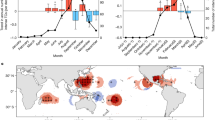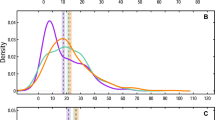Abstract
In my original Article1, I showed that there has been a significant upward trend in a measure of tropical-cyclone power dissipation over the past 30 years1. It is important to note that this measure is integrated over the life of the storm, and that the upward increase is evident in all major ocean basins prone to tropical cyclones. However, Pielke2 finds no discernible trend in hurricane damage in the United States after correction for inflation and demographic trends, and Landsea3 finds no trend in US landfall-based hurricane power dissipation back to the turn of the last century.
Similar content being viewed by others
Main
Pielke suggests2 that this apparent disparity could be explained if the power-dissipation trend I find is an artefact of the data and/or analysis methods, or if the trend is accurate but not a good predictor of damage. As this trend is large and universal — having about the same value in all the major ocean basins, despite different measurement techniques — and as it is well correlated with sea surface temperature (SST), which is relatively well measured, I stand by my conclusions about the trends in tropical-cyclone power dissipation.
I cannot discount the second of Pielke's conjectures, but the reason for the disparity may be more prosaic. Although Atlantic hurricanes do most of their destruction within 6–12 hours after landfall, they last for an average of 180 hours; moreover, only a fraction of hurricanes ever affect the US coastline. This means that the power-dissipation index (PDI) I used, which is accumulated over all storms and over their entire lives, contains about 100 times more data than an index related to wind speeds of hurricanes at landfall. There is large variability in wind speed over the life of each storm and large storm-to-storm random variability: detecting a temporal trend in the presence of this variability requires separation of the signal from the noise. With 100 times more data, my index has a signal-to-noise ratio that is ten times that of an index based on landfalling wind speeds. It is therefore possible that the real trend is detectable in the power dissipation but not in landfalling statistics. A simple calculation based on the observed root-mean-square variability of hurricane activity indicates that this is indeed the case, and probably explains why Pielke2 and Landsea3 find no trends in US landfall data.
Pielke argues that because El Niño can be detected in hurricane damage, a trend related to PDI should also be evident, if it exists. But the detectability of an El Niño signal in US hurricane damage is marginal, explaining only 3–4% of the variance4. Tropical Atlantic SST explains far more of the variance of both total Atlantic tropical-cyclone numbers and average tropical-cyclone intensity than does El Niño; but curiously, SST is even less correlated with a measure of US landfalling storm activity than El Niño. This probably once again reflects the difficulty of detecting trends in sparse time series in which the amplitude of random fluctuations is large compared with the signal.
The failure of any trend in landfall statistics to emerge from the noise is itself significant, and supports Pielke's view that demographic trends will be more important than climate change in coming years. But this is a short-term and US-centric view. When global tropical-cyclone activity is considered, and not just the 12% that occurs in the Atlantic region, a trend in landfalling intensity is already apparent; even in the Atlantic the signal, if it exists, is similar to the PDI trend, and if it continues should emerge from the noise in a few decades.
Landsea3 starts by saying that increasing SST has the potential for “slightly” increasing the intensity of tropical cyclones. But, as I discussed1, the existing theory and modelling5 on which this assertion is based suggest that the predicted ∼2 °C increase in tropical SST would increase wind speeds by 10% and, accounting for increased storm lifetime, increase power dissipation by 40–50%. This is hardly slight. The existing theory and modelling work5 are limited, however, in that they do not account for changes in environmental conditions, such as wind shear, and so only provide a loose guide as to what to expect.
Landsea correctly points out that in applying a smoothing to the time series, I neglected to drop the end-points of the series, so that these end-points remain unsmoothed. This has the effect of exaggerating the recent upswing in Atlantic activity. However, by chance it had little effect on the western Pacific time series, which entails about three times as many events. As it happens, including the 2004 and 2005 Atlantic storms and correctly dropping the end-points restores much of the recent upswing evident in my original Fig. 1 and leaves the western Pacific series, correctly truncated to 2003, virtually unchanged. Moreover, this error has comparatively little effect on the high correlation between PDI and SST that I reported1.
In correcting for biases in the original Atlantic tropical-cyclone data, I relied on a bias correction applied by Landsea6, presented as a table. I had fitted a polynomial to that correction, as I felt that a continuous rather than discrete correction was more defensible. Landsea believes that this had the effect of overcorrecting the most intense storms in the pre-1970 record, and I accept his revision to my analysis (Fig. 1b of ref. 3).
The Atlantic hurricane-intensity record by itself is not long enough to infer any connection between hurricanes and either global warming or multi-decadal cycles, but the high correlation between hurricane activity and tropical SST is remarkable (and largely unaffected by the corrections discussed), and the SST record is long enough to show the influence of global warming. To detect correlations with hurricane activity, tropical cyclones in the North Atlantic can be counted, assuming that detection of the presence of a storm by ships and islands is reliable (although intensity estimation is dubious before the mid-1940s). This count is highly correlated with both tropical Atlantic SST and Northern Hemispheric mean surface temperature through the entire record, casting doubt on whether the recent multi-decadal variability in tropical SST and hurricane activity is due purely to natural causes, as Landsea implies3.
I maintain that current levels of tropical storminess are unprecedented in the historical record and that a global-warming signal is now emerging in records of hurricane activity. This is especially evident when one looks at global activity and not just the 12% of storms that occur in the Atlantic. But I agree that there is a pressing need for a storm-by-storm reanalysis of tropical cyclones, not only in the North Atlantic, but also in the western North Pacific, where aircraft reconnaissance records also extend back to the 1940s.
References
Emanuel, K. Nature 436, 686–688 (2005).
Pielke, R. A. Jr Nature doi:10.1038/nature04426 (2005).
Landsea, C. W. Nature doi:10.1038/nature04477 (2005).
Katz, R. W. J. Appl. Meteorol. 41, 754–762 (2002).
Knutson, T. R. & Tuleya, R. E. J. Clim. 17, 3477–3495 (2004).
Landsea, C. W. Mon. Weath. Rev. 121, 1703–1714 (1993).
Author information
Authors and Affiliations
Rights and permissions
About this article
Cite this article
Emanuel, K. Emanuel replies. Nature 438, E13 (2005). https://doi.org/10.1038/nature04427
Published:
Issue Date:
DOI: https://doi.org/10.1038/nature04427
This article is cited by
-
Temporal evolution of hurricane activity: insights from decades of category 1–5 analysis
Environmental Earth Sciences (2024)
-
Interannual variation of tropical cyclone energy metrics over North Indian Ocean
Climate Dynamics (2017)
-
Tropical cyclones, climate change, and scientific uncertainty: what do we know, what does it mean, and what should be done?
Climatic Change (2011)
-
Tropical cyclone activity in global warming scenario
Natural Hazards (2011)
-
Large contribution of sea surface warming to recent increase in Atlantic hurricane activity
Nature (2008)
Comments
By submitting a comment you agree to abide by our Terms and Community Guidelines. If you find something abusive or that does not comply with our terms or guidelines please flag it as inappropriate.



